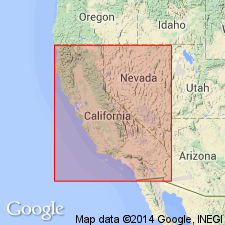
- Usage in publication:
-
- Huasna member
- Modifications:
-
- Named
- Biostratigraphic dating
- Dominant lithology:
-
- Sandstone
- Claystone
- AAPG geologic province:
-
- California Coast Ranges province
Summary:
Huasna member named as oldest member (of 3) of Santa Margarita formation in Phoenix-Saucelito Creeks area, south-central part of San Luis Obispo, CA. [Probably named for West Huasna fault or Huasna syncline]. Consists of white to gray-grown quartz arenite or arkosic wacke. In the west there is a siliceous shaly claystone facies. Composite columnar section shows unit is approximately 500 feet thick. Overlies Monterey formation; underlies Phoenix member (new) of Santa Margarita formation. Age is late Miocene based on PECTEN (AEQUIPECTEN) DISCUS Conrad.
Source: GNU records (USGS DDS-6; Menlo GNULEX).
For more information, please contact Nancy Stamm, Geologic Names Committee Secretary.
Asterisk (*) indicates published by U.S. Geological Survey authors.
"No current usage" (†) implies that a name has been abandoned or has fallen into disuse. Former usage and, if known, replacement name given in parentheses ( ).
Slash (/) indicates name conflicts with nomenclatural guidelines (CSN, 1933; ACSN, 1961, 1970; NACSN, 1983, 2005, 2021). May be explained within brackets ([ ]).

